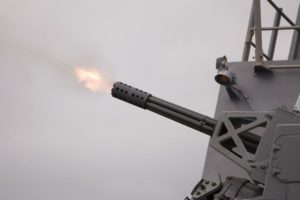
The National Interest:
The U.S. Navy is pursuing a massive, fleet-wide upgrade of a shipboard defensive weapon designed to intercept and destroy approaching or nearby threats such as enemy small boats, cruise missiles and even low-flying drones and aircraft, service officials said.
The Phalanx Close in Weapons System, or CIWS, is an area weapon engineered to use a high rate of fire and ammunition to blanket a given area, destroying or knocking enemy fire out of the sky before it can reach a ship. The Phalanx CIWS, which can fire up to 4,500 rounds per minute, has been protecting ship platforms for decades.
The weapon is designed to counter incoming enemy attacks from missiles, small arms fire, drones, enemy aircraft and small boats, among other things. It functions as part of an integrated, layered defense system in order to intercept closest-in threats, service officials explained.
“Phalanx provides a ‘last ditch’ gun-based, close-in defense to the Navy’s concept of layered defense,” Navy spokesman Dale Eng told Scout Warrior.
The weapon is currently on Navy cruisers, destroyers, aircraft carriers and amphibious assault ships, among other vessels. The upgrades are designed to substantially increase capability and ensure that the system remains viable in the face of a fast-changing and increasingly complex threat environment, Navy officials said.
The overhaul in recent years has consisted of numerous upgrades to the weapon itself, converting the existing systems into what’s called the Phalanx 1B configuration. At the same time, the CIWS overhaul also includes the development and ongoing integration of a new, next-generation radar for the system called the CIWS Phalanx Block IB Baseline 2, Navy officials explained.
The Block 1B configuration provides defense against asymmetric threats such as small, fast surface craft, slow-flying fixed and rotary-winged aircraft, and unmanned aerial vehicles through the addition of an integrated Forward-Looking Infra-Red (FLIR) sensor.
The Navy is now upgrading all fleet Phalanx Block 1B Baseline 0 and 1 Close-In Weapon Systems to the latest Phalanx Block IB Baseline 2 configuration, Eng said. The plan is to have an all CIWS Phalanx Block IB Baseline 2 fleet by fiscal year 2019, he added.
